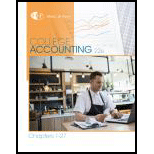
College Accounting, Chapters 1-27 (New in Accounting from Heintz and Parry)
22nd Edition
ISBN: 9781305666160
Author: James A. Heintz, Robert W. Parry
Publisher: Cengage Learning
expand_more
expand_more
format_list_bulleted
Question
Chapter 24, Problem 1CE
(a)
To determine
Compute the
(b)
To determine
Compute the
(c)
To determine
Calculate the quick ratio for Enterprise E.
Expert Solution & Answer
Want to see the full answer?
Check out a sample textbook solution
Students have asked these similar questions
Ans please
Ans
Abc
Chapter 24 Solutions
College Accounting, Chapters 1-27 (New in Accounting from Heintz and Parry)
Ch. 24 - A comparison of amounts for the same item in the...Ch. 24 - Prob. 2TFCh. 24 - Prob. 3TFCh. 24 - Prob. 4TFCh. 24 - Prob. 5TFCh. 24 - Prob. 1MCCh. 24 - Prob. 2MCCh. 24 - Working capital is a measure of (a) liquidity. (b)...Ch. 24 - Prob. 4MCCh. 24 - Prob. 5MC
Ch. 24 - Prob. 1CECh. 24 - Prob. 2CECh. 24 - Compute the following profitability measures for...Ch. 24 - Prob. 4CECh. 24 - Prob. 5CECh. 24 - Prob. 6CECh. 24 - Prob. 1RQCh. 24 - Prob. 2RQCh. 24 - Prob. 3RQCh. 24 - Prob. 4RQCh. 24 - Prob. 5RQCh. 24 - Prob. 6RQCh. 24 - Prob. 7RQCh. 24 - Prob. 8RQCh. 24 - Prob. 9RQCh. 24 - Prob. 10RQCh. 24 - Prob. 11RQCh. 24 - Prob. 12RQCh. 24 - Prob. 13RQCh. 24 - Prob. 1SEACh. 24 - Prob. 2SEACh. 24 - ANALY SIS OF PROFITABILITY Based on the financial...Ch. 24 - ANALY SIS OF LEVERAGE Based on the financial...Ch. 24 - Prob. 5SEACh. 24 - Prob. 6SEACh. 24 - Prob. 7SEACh. 24 - Prob. 8SPACh. 24 - Prob. 9SPACh. 24 - RATIO ANALYSIS OF COMPARATIVE FINANCIAL STATEMENTS...Ch. 24 - Prob. 1SEBCh. 24 - ANALYSIS OF ACTIVITY MEASURES Based on the...Ch. 24 - Prob. 3SEBCh. 24 - Prob. 4SEBCh. 24 - Prob. 5SEBCh. 24 - Prob. 6SEBCh. 24 - Prob. 7SEBCh. 24 - Prob. 8SPBCh. 24 - Prob. 9SPBCh. 24 - RATIO ANALYSIS OF COMPARATIVE FINANCIAL STATEMENTS...Ch. 24 - Prob. 1MPCh. 24 - This problem challenges you to apply your...
Knowledge Booster
Similar questions
- Financial Accounting Questionarrow_forwardKatherine Brewer is the stockholder and operator of Our Idol LLC, a motivational consulting business. At the end of its accounting period, December 31, 2017, Our Idol has assets of $574,000 and liabilities of $138,000. Using the accounting equation, determine the following amounts: a. Stockholders' equity as of December 31, 2017. b. Stockholders' equity as of December 31, 2018, assuming that assets increased by $109,000 and liabilities decreased by $33,000 during 2018.arrow_forwardAccountingarrow_forward
arrow_back_ios
SEE MORE QUESTIONS
arrow_forward_ios
Recommended textbooks for you
 College Accounting, Chapters 1-27AccountingISBN:9781337794756Author:HEINTZ, James A.Publisher:Cengage Learning,Principles of Accounting Volume 1AccountingISBN:9781947172685Author:OpenStaxPublisher:OpenStax College
College Accounting, Chapters 1-27AccountingISBN:9781337794756Author:HEINTZ, James A.Publisher:Cengage Learning,Principles of Accounting Volume 1AccountingISBN:9781947172685Author:OpenStaxPublisher:OpenStax College Intermediate Financial Management (MindTap Course...FinanceISBN:9781337395083Author:Eugene F. Brigham, Phillip R. DavesPublisher:Cengage Learning
Intermediate Financial Management (MindTap Course...FinanceISBN:9781337395083Author:Eugene F. Brigham, Phillip R. DavesPublisher:Cengage Learning Cornerstones of Financial AccountingAccountingISBN:9781337690881Author:Jay Rich, Jeff JonesPublisher:Cengage Learning
Cornerstones of Financial AccountingAccountingISBN:9781337690881Author:Jay Rich, Jeff JonesPublisher:Cengage Learning Survey of Accounting (Accounting I)AccountingISBN:9781305961883Author:Carl WarrenPublisher:Cengage Learning
Survey of Accounting (Accounting I)AccountingISBN:9781305961883Author:Carl WarrenPublisher:Cengage Learning

College Accounting, Chapters 1-27
Accounting
ISBN:9781337794756
Author:HEINTZ, James A.
Publisher:Cengage Learning,

Principles of Accounting Volume 1
Accounting
ISBN:9781947172685
Author:OpenStax
Publisher:OpenStax College

Intermediate Financial Management (MindTap Course...
Finance
ISBN:9781337395083
Author:Eugene F. Brigham, Phillip R. Daves
Publisher:Cengage Learning

Cornerstones of Financial Accounting
Accounting
ISBN:9781337690881
Author:Jay Rich, Jeff Jones
Publisher:Cengage Learning

Survey of Accounting (Accounting I)
Accounting
ISBN:9781305961883
Author:Carl Warren
Publisher:Cengage Learning
